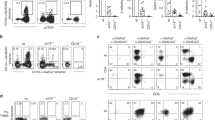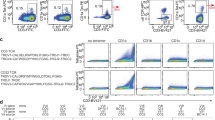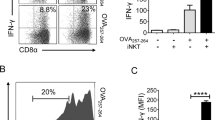Abstract
The CD1 family is a large cluster of non-polymorphic, major histocompatibility complex (MHC) class-I-like molecules that bind distinct lipid-based antigens that are recognized by T cells. The most studied group of T cells that interact with lipid antigens are natural killer T (NKT) cells, which characteristically express a semi-invariant T-cell receptor (NKT TCR) that specifically recognizes the CD1 family member, CD1d. NKT-cell-mediated recognition of the CD1d–antigen complex has been implicated in microbial immunity, tumour immunity, autoimmunity and allergy. Here we describe the structure of a human NKT TCR in complex with CD1d bound to the potent NKT-cell agonist α-galactosylceramide, the archetypal CD1d-restricted glycolipid. In contrast to T-cell receptor–peptide-antigen–MHC complexes, the NKT TCR docked parallel to, and at the extreme end of the CD1d-binding cleft, which enables a lock-and-key type interaction with the lipid antigen. The structure provides a basis for the interaction between the highly conserved NKT TCR α-chain and the CD1d–antigen complex that is typified in innate immunity, and also indicates how variability of the NKT TCR β-chain can impact on recognition of other CD1d–antigen complexes. These findings provide direct insight into how a T-cell receptor recognizes a lipid-antigen-presenting molecule of the immune system.
This is a preview of subscription content, access via your institution
Access options
Subscribe to this journal
Receive 51 print issues and online access
$199.00 per year
only $3.90 per issue
Buy this article
- Purchase on Springer Link
- Instant access to full article PDF
Prices may be subject to local taxes which are calculated during checkout




Similar content being viewed by others
References
Zinkernagel, R. M. & Doherty, P. C. Restriction of in vitro T cell-mediated cytotoxicity in lymphocytic choriomeningitis within a syngeneic or semiallogeneic system. Nature 248, 701–702 (1974)
Brigl, M. & Brenner, M. B. CD1: Antigen Presentation and T Cell Function. Annu. Rev. Immunol. 22, 817–890 (2004)
Clements, C. S. et al. Specificity on a knife-edge: the αβ T cell receptor. Curr. Opin. Struct. Biol. 16, 787–795 (2006)
Rudolph, M. G. et al. How TCRs bind MHCs, peptides, and coreceptors. Annu. Rev. Immunol. 24, 419–466 (2006)
Godfrey, D. I. et al. NKT cells: what's in a name? Nature Rev. Immunol. 4, 231–237 (2004)
Godfrey, D. I. & Kronenberg, M. Going both ways: immune regulation via CD1d-dependent NKT cells. J. Clin. Invest. 114, 1379–1388 (2004)
Kjer-Nielsen, L. et al. A structural basis for selection and cross-species reactivity of the semi-invariant NKT cell receptor in CD1d/glycolipid recognition. J. Exp. Med. 203, 661–673 (2006)
Gadola, S. D. et al. Structure and binding kinetics of three different human CD1d α-galactosylceramide-specific T cell receptors. J. Exp. Med. 203, 699–710 (2006)
Tynan, F. E. et al. T cell receptor recognition of a 'super-bulged' major histocompatibility complex class I-bound peptide. Nature Immunol. 6, 1114–1122 (2005)
Dellabona, P. et al. An invariant V alpha 24-J alpha Q/V beta 11 T cell receptor is expressed in all individuals by clonally expanded CD4-8- T cells. J. Exp. Med. 180, 1171–1176 (1994)
Porcelli, S. et al. Analysis of T cell antigen receptor (TCR) expression by human peripheral blood CD4–8- alpha/beta T cells demonstrates preferential use of several V beta genes and an invariant TCR alpha chain. J. Exp. Med. 178, 1–16 (1993)
Pyz, E. et al. The complementarity determining region 2 of BV8S2 (V beta 8.2) contributes to antigen recognition by rat invariant NKT cell TCR. J. Immunol. 176, 7447–7455 (2006)
Cui, J. Q. et al. Requirement for Vα14 NKT cells in IL-12-mediated rejection of tumors. Science 278, 1623–1626 (1997)
Gadola, S. D. et al. Vα24-JαQ-independent, CD1d-restricted recognition of α-galactosylceramide by human CD4+ and CD8 αβ+ T lymphocytes. J. Immunol. 168, 5514–5520 (2002)
Burdin, N. et al. Structural requirements for antigen presentation by mouse CD1. Proc. Natl Acad. Sci. USA 97, 10156–10161 (2000)
Kamada, N. et al. Crucial amino acid residues of mouse CD1d for glycolipid ligand presentation to Vα14 NKT cells. Int. Immunol. 13, 853–861 (2001)
Sidobre, S. et al. The Vα14 NKT cell TCR exhibits high-affinity binding to a glycolipid/CD1d complex. J. Immunol. 169, 1340–1348 (2002)
Bendelac, A. et al. The biology of NKT cells. Annu. Rev. Immunol. 25, 297–336 (2007)
Koch, M. et al. The crystal structure of human CD1d with and without alpha-galactosylceramide. Nature Immunol. 6, 819–826 (2005)
Zajonc, D. M. et al. Structure and function of a potent agonist for the semi-invariant natural killer T cell receptor. Nature Immunol. 6, 810–818 (2005)
Sidobre, S. et al. The T cell antigen receptor expressed by Vα14i NKT cells has a unique mode of glycosphingolipid antigen recognition. Proc. Natl Acad. Sci. USA 101, 12254–12259 (2004)
Godfrey, D. I. et al. CD1d antigen presentation: treats for NKT cells. Nature Immunol. 6, 754–756 (2005)
Schumann, J. et al. Cutting edge: influence of the TCR Vβ domain on the avidity of CD1d:α-galactosylceramide binding by invariant Vα14 NKT Cells. J. Immunol. 170, 5815–5819 (2003)
Schumann, J. et al. Targeted expression of human CD1d in transgenic mice reveals independent roles for thymocytes and thymic APCs in positive and negative selection of Vα14i NKT Cells. J. Immunol. 175, 7303–7310 (2005)
Tynan, F. E. et al. A T cell receptor flattens a bulged antigenic peptide presented by a major histocompatibility complex class I molecule. Nature Immunol. 8, 268–276 (2007)
Cantu, C. et al. The paradox of immune molecular recognition of α-galactosylceramide: low affinity, low specificity for CD1d, high affinity for αβ TCRs. J. Immunol. 170, 4673–4682 (2003)
Zhou, D. et al. Lysosomal glycosphingolipid recognition by NKT cells. Science 306, 1786–1789 (2004)
Kinjo, Y. et al. Recognition of bacterial glycosphingolipids by natural killer T cells. Nature 434, 520–525 (2005)
Mattner, J. et al. Exogenous and endogenous glycolipid antigens activate NKT cells during microbial infections. Nature 434, 525–529 (2005)
Sriram, V. et al. Cell wall glycosphingolipids of Sphingomonas paucimobilis are CD1d-specific ligands for NKT cells. Eur. J. Immunol. 35, 1692–1701 (2005)
Kinjo, Y. et al. Natural killer T cells recognize diacylglycerol antigens from pathogenic bacteria. Nature Immunol. 7, 978–986 (2006)
Wu, D. Y. et al. Cross-presentation of disialoganglioside GD3 to natural killer T cells. J. Exp. Med. 198, 173–181 (2003)
Fischer, K. et al. Mycobacterial phosphatidylinositol mannoside is a natural antigen for CD1d-restricted T cells. Proc. Natl Acad. Sci. USA 101, 10685–10690 (2004)
Rauch, J. et al. Structural features of the acyl chain determine self-phospholipid antigen recognition by a CD1d-restricted invariant NKT (iNKT) cell. J. Biol. Chem. 278, 47508–47515 (2003)
Vagin, A. & Teplyakov, A. An approach to multi-copy search in molecular replacement. Acta Crystallogr. 56, 1622–1624 (2000)
Kjer-Nielsen, L. et al. A structural basis for the selection of dominant αβ T cell receptors in antiviral immunity. Immunity 18, 53–64 (2003)
Acknowledgements
We thank the staff at the IMCA beamline at the Advanced Photon Source for assistance with data collection. The Australian Research Council (ARC), the National Health and Medical Research Council of Australia (NHMRC), the Cancer Council of Victoria and a Monash Early Career Research grant (N.A.B.) supported this research. D.G.P. and D.I.G. receive support from an RO1 grant from the National Institutes of Health and the Association of International Cancer Research. G.S.B. acknowledges support in the form of a Personal Research Chair from J. Bardrick, as a former Lister Institute-Jenner Research Fellow, the Medical Research Council (UK) and the Wellcome Trust; N.A.B. is supported by an NHMRC Peter Doherty Fellowship, D.I.G. by an NHMRC Principal Research Fellowship, and M.C.J.W. by an NHMRC Senior Research Fellowship. J.R. is supported by an ARC Federation Fellowship.
Author Contributions N.A.B. performed experimental work, analysis and prepared the manuscript; K.S.W., L.K.N., M.C.J.W., D.P., M.B. performed experimental work; G.S.B. provided essential reagents; D.I.G. devised the project, analysed data and wrote the manuscript; and J.M. and J.R. are joint senior and corresponding authors—they co-led the investigation, devised the project, analysed the data and wrote the manuscript.
The X-ray crystallographic coordinates and structure factor files have been deposited in the Protein Data Bank with accession number 2PO6.
Author information
Authors and Affiliations
Corresponding authors
Ethics declarations
Competing interests
The X-ray crystallographic coordinates and structure factor files have been deposited in the Protein Data Bank with accession number 2PO6. Reprints and permissions information is available at www.nature.com/reprints. The authors declare no competing financial interests.
Supplementary information
Supplementary Information
This file contains Supplementary Figures S1-S5 with Legends and Supplementary Tables S1-S2. (PDF 1336 kb)
Rights and permissions
About this article
Cite this article
Borg, N., Wun, K., Kjer-Nielsen, L. et al. CD1d–lipid-antigen recognition by the semi-invariant NKT T-cell receptor. Nature 448, 44–49 (2007). https://doi.org/10.1038/nature05907
Received:
Accepted:
Published:
Issue Date:
DOI: https://doi.org/10.1038/nature05907
This article is cited by
-
Identification of a broad lipid repertoire associated to the endothelial cell protein C receptor (EPCR)
Scientific Reports (2022)
-
Natural and synthetic carbohydrate-based vaccine adjuvants and their mechanisms of action
Nature Reviews Chemistry (2021)
-
Reduced dose of PTCy followed by adjuvant α-galactosylceramide enhances GVL effect without sacrificing GVHD suppression
Scientific Reports (2021)
-
Unveiling the heterogeneity of NKT cells in the liver through single cell RNA sequencing
Scientific Reports (2020)
-
A single-domain bispecific antibody targeting CD1d and the NKT T-cell receptor induces a potent antitumor response
Nature Cancer (2020)
Comments
By submitting a comment you agree to abide by our Terms and Community Guidelines. If you find something abusive or that does not comply with our terms or guidelines please flag it as inappropriate.



